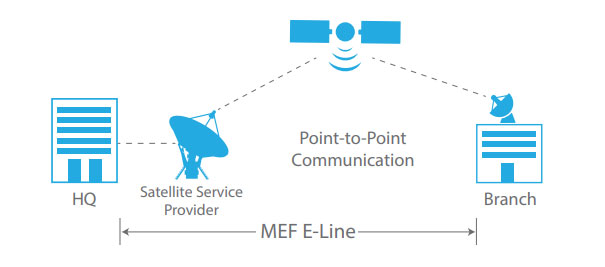 MEF is a global industry association of leading service and technology providers in telecommunications and data services. MEF has been developing Carrier Ethernet standards for more than two decades.
MEF is a global industry association of leading service and technology providers in telecommunications and data services. MEF has been developing Carrier Ethernet standards for more than two decades.
ALEXANDRIA, Va. — In today’s connected world, it is rare to find interoperability between satellite and terrestrial networks. The most common analogy to describe the situation is that the different connectivity players don’t speak the same language.
Given the potential $35 billion in revenue opportunities for the convergence of satellite communications and global telecommunications by 2035, there is growing recognition that the space sector will need to learn to speak using terrestrial standards—not the other way around.
“The language that a lot of enterprises are talking today is Carrier Ethernet service,” said Daniel Bar-Lev, MEF Vice President of Strategic Programs. “What we’ve seen is more and more satellite players saying, ‘We want to be capable of delivering Carrier Ethernet service—or at least letting that service run effectively over our satellite networks.’ That’s that universal language.”
MEF is a global industry association whose membership represents top service and technology providers across telecommunications and data services. The organization began over 20 years ago with standards for Carrier Ethernet, the protocol for high-speed, carrier-class Ethernet services. That widely-used protocol defines standardized packet access to the internet and uses common Ethernet interfaces to support interoperability among network operators, service providers, vendors and customers.
Rather than offering specialized connectivity services in megahertz or MODCOD, there is a shift in the satellite industry to adopt standard definitions and interfaces used by terrestrial players. As the first GEO operator to achieve MEF 3.0 Carrier Ethernet certification, Intelsat is keen on the advantages of standardized services. Intelsat Vice President of Systems Architecture and Innovation Sunil Gottipati explained that product and service parity with terrestrial operators is an important benefit of MEF certification, such that satellite links become seamless to customers and other providers in the connectivity ecosystem.
“They don’t have to think of satellite as anything different,” said Gottipati. “We’re a part of the broader telco ecosystem and that is how we look at ourselves.”
How Satellite Became a Part of MEF
Currently, several satellite players are members of MEF, including G&S Satcom, iDirect, Intelsat, Kratos, Rivada Space Networks, SES, Telesat and others. However, only a small handful are MEF-certified.
The involvement of satellite companies in MEF started around 2018 when Intelsat approached the organization with the idea of establishing a standard class of service for Carrier Ethernet over satellite. At that time, Intelsat had spent nearly a decade developing a global unified network based on an IP MPLS core to interconnect teleports with terrestrial customers, such as internet service providers and mobile network operators. As that work progressed, there was growing interest in IP and Ethernet services and standardization of those services over satellite, which led to MEF.
“When you look at the MEF standards, the performance specifications … were really geared toward terrestrial providers,” said Gottipati. Latency, in particular, was an issue for non-terrestrial operators.
Intelsat then began work on an amendment to establish a new performance tier for Carrier Ethernet over satellite-based networks. In 2021 the forum released MEF 23.2.2, its first specification for Class of Service (CoS) parameters to differentiate satellite network traffic.
Adapting to terrestrial standards has required a significant investment of resources and time and a big challenge for satellite operators, according to Gottipati, has been moving supply chains toward standardization.
“We keep encouraging our vendors to become standards compliant and get away from proprietary notations of waveforms and protocols,” said Gottipati. “That’s really the biggest barrier to standardization in the satellite world, the proprietary nature of the hardware and software that’s used in these networks.”
Intelsat is currently working with Kratos, a MEF-certified vendor, to enable satcom services to run in a standardized way to terrestrial partners. “We didn’t make up our own interfaces or our own definitions of what a connectivity service should look like,” said Markus Eslitzbicher, Director of Product Management at Kratos, who led the MEF certification process. “We speak MEF language that is familiar immediately to any telecom. And that’s a massive reduction in the friction, the overhead and the complexity of interconnecting terrestrial systems and satcom systems.”
Reducing Complexity and Avoiding Market Fragmentation
In the simplest terms, MEF standards enable plug-and-play interactions between parties in the connectivity ecosystem. That makes it easier for operators, connectivity providers and their customers to interoperate and create chains of defined connectivity services.
“You’re normalizing how services get ordered,” said Gottipati. “You’re already reducing a lot of the complexity by standardizing towards a Carrier Ethernet type service. So, when somebody buys an E-Line service, it doesn’t matter whether they’re buying it from a terrestrial service provider or a satellite service provider.”
 An example of Carrier Ethernet over satellite E-Line providing carrier-grade Layer 2 services. (Source: Kratos)
An example of Carrier Ethernet over satellite E-Line providing carrier-grade Layer 2 services. (Source: Kratos)
That level of standardization not only reduces market fragmentation, but also increases return on investment and fuels innovation among participating players, explained Bar-Lev. “You don’t have to reinvent every time [there’s a new] service or product or interoperability with a new player. You develop once and you use it many times,” he said.
Adopting widely used standards cuts the cost and burden of repetitive development and integration from weeks or months to potentially hours or days. Additionally, replacing manual processes with automation and orchestration is a prerequisite for providing satellite connectivity service at scale to meet the demand of millions of endpoints in today’s telecommunications ecosystem.
Standardizing the ‘What’ and the ‘How’
As Bar-Lev noted, MEF is not only about streamlining a service but also simplifying the process of providing it. “You have to not only standardize what is being sold but also standardize as much as possible how it’s bought and sold,” he said.
The “what,” is the service being provided, Bar-Lev explained, such as Carrier Ethernet, IP or SD-WAN. It’s the flow of bits and packets from one place to another and the ability to provide application-aware connectivity between virtually any set of points on Earth.
“The ‘how’ is: how do I specify to my partners the location that I need connectivity for? How do I know … what they can deliver? How do I know how much it’s going to cost? How do I place an order and raise a ticket when something goes wrong?” he continued.
The interaction between operator, provider and customer falls under MEF Lifecycle Service Orchestration (LSO). By adopting MEF-defined software interfaces, the parties involved can communicate with one another more easily and seamlessly than picking up the phone or sending an email. This level of communication relates primarily to business automation, such as ordering, billing, delivery as well as starting, stopping or modifying a service.
For satellite players participating in MEF, the goal is to make satcom look more like familiar terrestrial services. Through standardization and automation, satcom becomes easier to consume, which lowers business friction and, in turn, allows for more business opportunities.
Seeking Satcom Input
There are several options for space companies to get more plugged in to the global connectivity network by getting involved with MEF. In just a few years, a growing number of satellite operators and space tech companies are seizing on these opportunities to influence and participate in the future connectivity landscape.
One opportunity is for satellite companies to contribute subject matter expertise to MEF’s inter-industry collaborations. It is particularly valuable to MEF to have organizations that understand satellite communications given the increased interest in satellite-based services to extend the reach of terrestrial networks, said Bar-Lev.
MEF also provides opportunities for organizations to collaborate in groups called MEF Accelerators. These are ongoing collaborative projects within the MEF community where members work together to demonstrate a solution or create a service based on forum standards. Currently, there is at least one MEF Accelerator focused on satcom solutions that is still in its early stages.
MEF leaders are actively seeking more input from the satellite community. According to Bar-Lev, that could include guidance on matching the dynamic performance needs of users or applications in multi-orbit scenarios, or practical examples for interfacing satcom and 5G or 6G networks. “We would really like to see those use cases that are meaningful to the satellite industry,” said Bar-Lev. “That is our request from the MEF side.”
Explore More:
Satellite Operators, Vendors Showcase Integrated Satcom Service Using Telco Standards
Podcast: Satellite and Telecom Integration, Carrier Ethernet and Servicing New Markets
NSR White Paper: Telecom-Satcom Digital Network Integration
